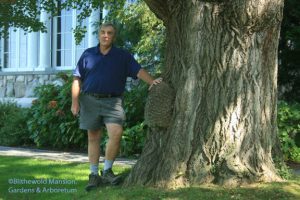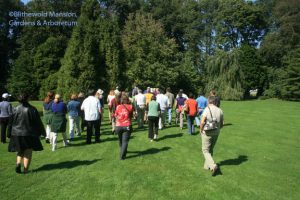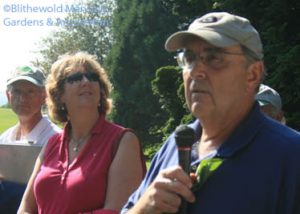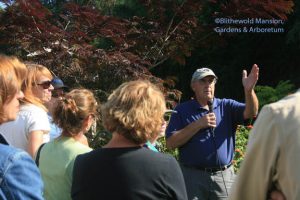Horticulture is Dirr(ty) work
 If you tell someone you found it in “Dirr” they’ll know you mean the Manual of Woody Landscape Plants: Their Identification, Ornamental Characteristics, Culture, Propagation and Uses (now in its 6th edition). But Michael A. Dirr, PhD has also written The Book on viburnums (Viburnums: Flowering Shrubs for Every Season), The Book on hydrangeas (Hydrangeas for American Gardens) co-written by his wife Bonnie, and several other coffee-table-worthy, destined-to-be-dogeared reference books. What makes his books worth consulting – and reading from cover to cover – is not just the breadth of information but that they’re thick with pithy opinions. I found out yesterday that Mike is just as entertaining and full of it (I mean knowledge) in person.
If you tell someone you found it in “Dirr” they’ll know you mean the Manual of Woody Landscape Plants: Their Identification, Ornamental Characteristics, Culture, Propagation and Uses (now in its 6th edition). But Michael A. Dirr, PhD has also written The Book on viburnums (Viburnums: Flowering Shrubs for Every Season), The Book on hydrangeas (Hydrangeas for American Gardens) co-written by his wife Bonnie, and several other coffee-table-worthy, destined-to-be-dogeared reference books. What makes his books worth consulting – and reading from cover to cover – is not just the breadth of information but that they’re thick with pithy opinions. I found out yesterday that Mike is just as entertaining and full of it (I mean knowledge) in person.
Mike’s slides were, unfortunately, a little tough to see due to the brilliance of a perfect day but the afternoon tree tour of the University of Blithewold (it felt like a campus yesterday) was a spectacular pleasure. I’m still trying to process it all. I’m sure I wasn’t the only one in the group of local industry professionals, savvy cognoscenti and at least one fellow blogger, straining to catch every second of his mile-a-minute professorial banter. Everyone looked as riveted, and by the end of the day, as overwhelmed as I felt. I’m so relieved that there’s not going to be a quiz – but I’ll try to recap just a little for you.
 The event was co-sponsored by the New England chapter of the International Society of Arboriculture, and the topics – fitting for that group and ours – were noble trees and new introductions. Mike pointed out that you always know a noble tree when you see it – you don’t even have to know what it is, just that it has a venerable stature, grace, beauty and presence. It’s a squirrel highway and a landmark and Blithewold is blessedly full of them. It most certainly isn’t a Bradford pear (Pyrus calleryana) which has become not only the most ubiquitous street tree but has turned out to be invasive as well. And certainly not enough truly noble trees are being planted today for the benefit of future generations. Have you planted any? Which ones? Do you have a favorite noble tree? (Mine is a particular linden in a particular Middletown garden – even though – or because – I’ve nearly been knocked cold a couple of times by its enormous akimbo elbows.)
The event was co-sponsored by the New England chapter of the International Society of Arboriculture, and the topics – fitting for that group and ours – were noble trees and new introductions. Mike pointed out that you always know a noble tree when you see it – you don’t even have to know what it is, just that it has a venerable stature, grace, beauty and presence. It’s a squirrel highway and a landmark and Blithewold is blessedly full of them. It most certainly isn’t a Bradford pear (Pyrus calleryana) which has become not only the most ubiquitous street tree but has turned out to be invasive as well. And certainly not enough truly noble trees are being planted today for the benefit of future generations. Have you planted any? Which ones? Do you have a favorite noble tree? (Mine is a particular linden in a particular Middletown garden – even though – or because – I’ve nearly been knocked cold a couple of times by its enormous akimbo elbows.)
 It is new introductions of trees and shrubs that keep the industry on its toes. Mike and Bonnie are on the constant look-out for unusual traits in trees and shrubs and have had a few “85 mph” drive-by finds introduced into commerce. (Keep your eyes peeled for a new redbud called ‘Bonnie’s Pink’.) We all want something new and different (we can’t help it) and with a trained eye any one of us could find the next winner, have it tested, propagated and introduced. The lesson I take from that is simply to pay more attention even to the old stand-by, tried-and-trues. How is it that I never in my life really noticed a hornbeam before yesterday? The professor in Mike brought out the student in me. I’m still interested all over again. And I’ve got a(helluva) lot to learn and a few of my own opinions to cultivate. How about you?
It is new introductions of trees and shrubs that keep the industry on its toes. Mike and Bonnie are on the constant look-out for unusual traits in trees and shrubs and have had a few “85 mph” drive-by finds introduced into commerce. (Keep your eyes peeled for a new redbud called ‘Bonnie’s Pink’.) We all want something new and different (we can’t help it) and with a trained eye any one of us could find the next winner, have it tested, propagated and introduced. The lesson I take from that is simply to pay more attention even to the old stand-by, tried-and-trues. How is it that I never in my life really noticed a hornbeam before yesterday? The professor in Mike brought out the student in me. I’m still interested all over again. And I’ve got a(helluva) lot to learn and a few of my own opinions to cultivate. How about you?
